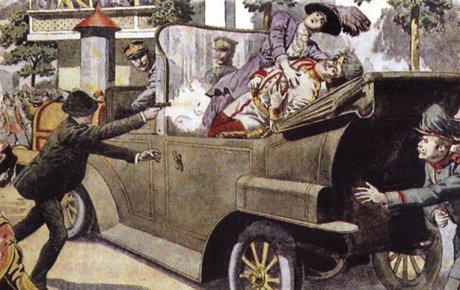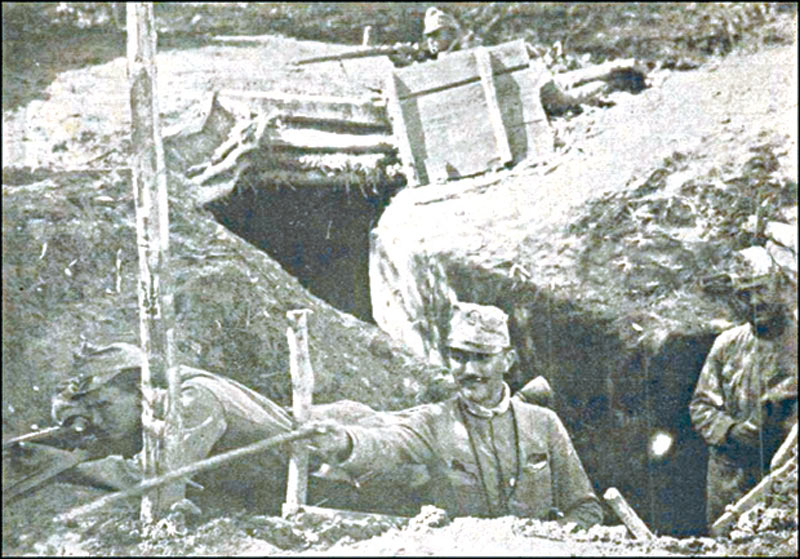Period:
First World War
Region:
Yugoslavia
The Croatian Devil's Division
The 42. Home Guard Infantry Division, also known as the Devil’s Division was a Croatian war unit of the Zagreb 13th Corpus of the Austro-Hungarian Army.
This infantry division was formed at the beginning of July 1914 when the Austro-Hungarian government declared a total mobilization after Franz Ferdinand's assassination on the Serbian National Day (Vidovdan) in Sarajevo. The mobilization included the empire’s three regions- Croatia, Slavonija, Dalmatia, and Bosnia and Herzegovina.

The unit was primarily made of three national ethnicities- over 70% of Croats, 28% Serbs, and a few Hungarians.
The unit was notorious for the horrible war crimes committed by its members at the beginning of WW1, in the summer and autumn of 1914, in the north and west parts of the Kingdom of Serbia and along the Bosnian coast of the river Drina.
After the Austro-Hungarian defeat in the Balkans, the unit was transported to Galicia, and later to the western parts of Slovenia where they had a conflict with Italians all the time until the end of the Great War. When the war finished, the unit fell apart and retreated to Croatia.
BACKGROUND
In the summer of 1914, the assassination of Austrian prince Franz Ferdinand in Sarajevo by members of the Mlada Bosna (Gavrilo Princip, Bogdan Žerajić, etc.) served as a pretext for the Austro-Hungarian monarchy to attack the Kingdom of Serbia. This was the beginning of WWI.

Gavrilo Princip
The telegram from Vienna was sent to Serbia containing 10 unacceptable requests. This was a declaration of war of Austria-Hungary against the Kingdom of Serbia. Montenegrian king Nikola Petrović and Russian Tzar Nikolaj II Romanov immediately respond with words of support, stating that they would help Serbia. At the same time, German emperor Kaiser Wilhelm II created an alliance with the Vienna Court.
FORMATION OF THE DIVISION
When members of the revolutionary organization Mlada Bosna committed the assassination of Austrian duke and prince Franz Ferdinand and his wife on 28th June 1914, the Royal Government of Austro-Hungary declared mobilization throughout its entire territory after it had been preparing for years to begin the war against the Kingdom of Serbia.
The Vienna court issued an ultimatum in July 1914 with 10 requests that couldn’t have been fulfilled. The Serbian government didn’t accept one of the totals of 10, and this served as a reason to declare war on Serbia on 28 July 1914.
At the beginning of July 1914, Austro-Hungarian Army conducted a mobilization of all military-aged men between 18 and 55, in wider areas of Zagreb,
They all received Austrian blue uniforms, and weapons, and were ordered to go toward Serbia which needed to be defeated and destroyed. During the period of three weeks, all units were filled. The Croatian 42nd Division was part of the 13th Zagreb Corpus within the Fifth Army of Austro-Hungary.
COMPOSITION OF THE DIVISION
The Croatian 42nd Home Guard Infantry Division consisted of the following units:
The 83rd Infantry Brigade- Zagreb
- The 25th Zagreb Home Guard Regiment
- The 26th Karlovac Home Guard Regiment
The 84th Infantry Brigade- Osijek
- The 27th Sisak Home Guard Regiment
- The 28th Osijek Home Guard Regiment
The 10th Cavalry Regiment -Varaždin
The 42nd Artillery Brigade - Zagreb
- The 37th Zagreb Field Artillery Regiment
- The 6th Zagreb Field Artillery Regiment
Prominent commanders of the Croatian 42nd Devil’s Division were Stjepan Sarkotić, Mihovil Mihaljević, Ivan Salis Seevis, Karl Stracker, Luka Šnjarić, Anton Lipošćak, Teodor Soretić. They were generals and Croats by nationality.
Well-known members of this division were Vlatko Maček, Slavko Kvarternik, and Josip Broz Tito (the member of the 10th troop of the 25th Zagreb Home Guard Regiment), Miroslav Krleža, and others…
CRIMINAL ODYSSEY
At the end of July 1914, the Croatian 42nd division had about 25,000 soldiers organized in seven regiments. The division was located in the northern part of the Bosnian coast of the Drina river.

Here is important to note that a lot of Serbs in Austrian uniforms fleed to join the Serbian army. This also happened in the Zagreb 13th Corpus and the Devil's Division. They didn't want to shoot at their brothers from Serbia.
The region of Drina river and Mačva
This unit was one of the first that crossed the river Drina in August 1914 and came into the territory of the Kingdom of Serbia. They immediately began with bloody crimes against innocent civilians, largely women, children, and the elderly. Their crimes were unimaginably cruel and fierce.
They put children on sticks, and sword bayonets. Women and girls were raped. They even cut women’s breasts. They burned property and churches in every place they set their foot. Those beasts especially enjoyed in hanging civilians in their gardens and orchards. Furthermore, they hammered Serbs on a wooden cross and crucified them like Jesus Christ was.
A lot of places in the Drina region and Mačva were almost entirely eradicated. Only in the village of Prnjavor in Mačva, members of the Croatian 42nd Home Guard Division slaughtered more than 350 Serbs in just a few days.
Serbian Second Army under command of general Stepa Stepanović expelled Austro-Hungarian occupation forces that retreated to Bosnia in panic and chaos. Among them was the Croatian 42nd Home Guard Division. Serbs gained victory mostly thanks to the Second Infantry regiment “Knjaz Mihailo”.
However, later in September 1914, Austro-Hungarian units conducted a second fierce attack near Banja Koviljača in Gučevo and at mountain Jagodnja, on its famous peak “Mačkov kamen”. On that occasion, the 25th Zagreb Home Guard Regiment of the Devil’s Divison performed deep penetration towards the city of Valjevo where they occupied the village of Baćinovac. Wherever they set their foot, they left bloody traces.
Chetnik unit of Vojvoda Vuk (Vojsilav Tankosić) and Devils’ Division collided at Gučevo. During this clash, of the total of 700 soldiers, only 50 survived.
On 11 November 1914, a change of command took place within the Croatian 42nd Divison, when general mayor Ivan Salic Selvis replaced general Sarkotić. After a few days, the third major attack on Serbia occurred in the valley of the river Kolubara, mountain Rajac, and Suvobor, where battles raged between two armies.

Josip Broz Tito as member of Devil’s Division in 1914
This was when the Croatian 42nd Home Guard Division advanced to the town of Ljig. Together with other Austro-Hungarian units, they had short success when they penetrated deep into the Šumadija region, entering Belgrade on 1 December 1914. They even organized a celebration feast day later believing that Serbia was defeated and that it was only a matter of days before it was going to capitulate.
On the contrary, on 3 December 1914, general Živojin Mišić ordered a decisive counterattack of the Serbian First Army after allowing two days of break and redeployment. This surprised Austro-Hungarians, and the front broke on several points which caused their units to retreat in panic again to Bosnia.
After this great defeat, the Croatian 42nd Home Guard Division retreated to recover from casualties, and refill with new soldiers.
Montenegro
The fourth attack of Austro-Hungary against Serbia in October 1915 was marked by the joining of Germany and Bulgaria. This meant that almost a million soldiers advanced toward Serbia.
After recovering, the Devil’s Divison was redeployed to the so-called South front where it was involved in battles with the Army of the Kingdom of Montenegro at the end of 1915 and beginning of 1916. Here also, members of this notorious division repeated their criminal odyssey.

After the capitulation of Montenegro at the end of January 1916, and after king Nikola I Petrović went into exile, the entire 42nd Division together with other divisions of the Croatian 13th corpus was sent to the Eastern front, to the Carpathian mountains.
Casualties
During their involvement in the battles of Cer, Drina, and Kolubara on the territory of the Kingdom of Serbia, between August and December 1914, the Croatian 42nd Home Guard Division lost 270 officers, 550 non-commissioned officers, and around 5,000 soldiers.
Despite these tremendous casualties, the Hazburgh monarchy ordained commanders of regiments, battalions, units, and troops. The Commander of this division was awarded with the Order of Iron Crown as a Knight 2nd Class.
In Galicia, the Devil’s Division suffered great losses during the period of two years because they couldn’t handle Carpathian coldness. They lost more than 70 officers, and 3,500 non-commissioned officers and soldiers.
YEARS LATER
When aggression on the Kingdom of Yugoslavia took place during WW2, Josip Broz Tito was among communists in the Drina region and Šumadija trying to sparkle a rebellion with the aim to raise a socialistic revolution.
In Autumn 1914, Broz came to the eastern Drina coast. Here, after Aleksandar Ranković commented that he had good orientation and knew toponyms of this region very well, Tito answered:
“But, of course, I know…I was fighting here 27 years ago…”
After Ranković’s initial confusion, he said to Tito never to say this again because they would be killed.
PUBLICATIONS
Not many studies have been made regarding the evil deeds of the notorious Croatian 42nd Infantry Home Guard Division. Not even a documentary has been made for more than one century. After Second World War, socialistic communist Yugoslavia was created whose leader was Josip Broz Tito himself, so it was forbidden to tell any story about the Croatian 42nd Division.
Furthermore, stories and testimonies about crimes against Serbs in the 1st and 2nd World Wars were not welcome because they were considered a threat to the brotherhood and unity of South Slav nations on the basis of which the Federal State of Yugoslavia was created.
Only in 2016, Ljubomir Jevremović from the production studio Soko film made a movie called “Ljubovijski odred” (Regiment of Ljubovija). The plot centers around a small unit of the 5th Regiment “Kralj Milan” of the Drina Division which had a bitter battle with the Devil’s Division near the village of Pecka in Kolubara County.
Austro-Hungarian lieutenant Marko Jakovljevjić published his book “From war and emigration”, in 1923. in Subotica. He described the attitude of Croats in Austro-Hungarian uniforms during the war in Serbia, in 1914:
“At the beginning of the war, those people largely behaved as bitter enemies of Serbia. They fought fanatically and heroically in battles, and they conducted evils in Serbia, just like Hungarians. Those battles for seizing the most important places in western Serbia are the most beautiful chapters of Croatian war history.
At the mountain Gučevo, Crni Vrh, and Kulište, all our Croatian infantry divisions prove themselves. Participants of these fights will remember the wonderful strikes of our regiments. They didn’t care about losses, our soldiers and officers were dying during fights “face to face”
The Commander of the brigade was Croatian general Petković, born in Šokadija, who was awarded the title of baron because of his heroic attitude, and during the battle at trench near Krupanj, Slavko Štancer (later a general in the army of the Independent State of Croatia) lost his hand while commanding his unit.
Tags:
Please, vote for this article:
Visited: 2367 point
Number of votes: 0
|